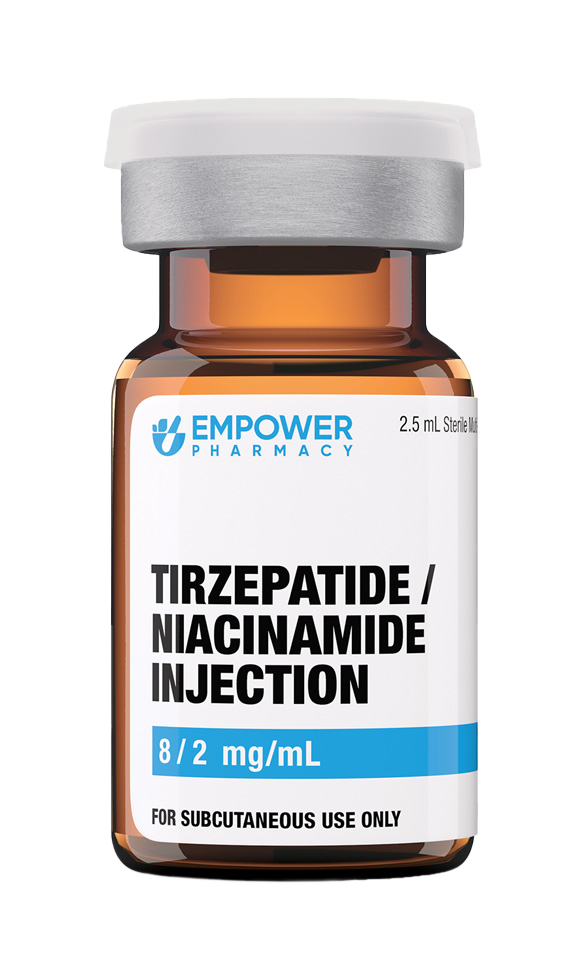
Article Summary
All three GLP-1s — semaglutide, tirzepatide, and liraglutide — offer significant benefits in managing type 2 diabetes and weight loss, but they differ in their administration schedules, efficacy, and additional benefits. Choosing the optimal therapy requires thoroughly evaluating patient-specific factors, including treatment goals, lifestyle, and comorbid conditions.
Weight Management and GLP-1s
We live in a nation where nearly 1 in 3 adults are overweight and 2 in 5 adults suffer from obesity, according to the National Institutes of Health (NIH). If we look closer, men show a higher percentage of being overweight compared to women.
GLP-1s have revolutionized the fight against diabetes since their market entry in the mid-2000s. These peptide hormones were developed initially as a type 2 diabetes treatment that works with the pancreas to enhance insulin release in response to meals. However, researchers observed during clinical trials and from post-release reports that patients using GLP-1s also showed weight loss. They work by reducing the appetite and feelings of hunger, slowing the release of food from the stomach, and increasing fullness after eating.
Fast-forward a couple of decades, and now we have GLP-1s with unique profiles, such as semaglutide, tirzepatide, and liraglutide, the market that can help optimize patient outcomes. Let’s look at their characteristics, efficacy, and considerations.
Fun Fact:
Did you know the first GLP-1 gene identified was found in deep-sea-dwelling Atlantic anglerfish in 1982? Scientists eventually identified similar genes in rodents and humans.
Source: National Institute of Diabetes and Digestive Kidney Diseases.
Comparing Semaglutide, Tirzepatide, and Liraglutide
GLP-1 receptor agonists have revolutionized the management of type 2 diabetes, offering patients improved glycemic control and substantial weight loss. Semaglutide, tirzepatide, and liraglutide are prominent among these agents. Understanding their differences, efficacy, and unique profiles is crucial for optimizing patient outcomes.

Semaglutide
Semaglutide is a popular and efficacious once-weekly GLP-1 receptor agonist notable for its robust efficacy.
Its modified version of the human GLP-1 structure extends its half-life and is generally considered safe in adults and elderly patients with kidney or liver disorders ( Mahapatra et al., 2021).
Clinical research like the STEP trial demonstrates that semaglutide shows an average weight reduction of approximately 15 percent in obese folks without type 2 diabetes (Ruseva et al., 2024).

Tirzepatide
Tirzepatide brings a novel dual GIP and GLP-1 receptor agonist, advancing beyond traditional GLP-1 therapy.
This unique mechanism of action enhances its efficacy in glucose control and weight management, even showing superior glucose and weight reduction levels to other GLP-1s, including semaglutide. (Nauck et al., 2022).
This GLP-1 receptor agonist also shows promise in recent studies to improve cardiovascular health (Sardar et al., 2024).
On the flip side, healthcare professionals need to monitor for potential side effects such as gastrointestinal disturbances, which are common with GLP-1 receptor agonists, and the risk of pancreatitis (Frias et al., 2021).

Liraglutide
Liraglutide is a daily injectable GLP-1 receptor agonist that offers good glycemic control and cardiovascular benefits, as documented by the LEADER trial (Marso et al., 2016).
Despite its proven benefits, the need for daily administration may be less convenient compared to the weekly dosing of similar drugs, which could potentially impact patient adherence.
Liraglutide is also associated with gastrointestinal side effects, which are typically mild but may require management in some patients . (Wu et al., 2023)
In summary, while all three GLP-1s—semaglutide, tirzepatide, and liraglutide —offer significant benefits in managing type 2 diabetes and weight loss, they differ in their administration schedules, efficacy, and additional benefits. Semaglutide and tirzepatide, with their longer dosing intervals and superior weight loss outcomes, offer compelling advantages for patients needing intensive management. Liraglutide remains a valuable option, particularly for those who prefer daily medication and may benefit from its proven cardiovascular safety profile. Choosing the optimal therapy requires thoroughly evaluating patient-specific factors, including treatment goals, lifestyle, and comorbid conditions.
Looking to source GLP-1s for your patients?
Set up your Empower Pharmacy account today to get started.
Are you a patient looking to start your weight loss journey?
As a 503A compounding pharmacy, we fulfill prescriptions nationwide. Speak to your provider today to get started with Empower Pharmacy today.
At Empower, we are a nationwide trusted 503A compounding pharmacy that works with the FDA when there is a medication shortage. We answer the call with rigorous quality assurance processes, that involve testing raw materials and final products to meet stringent purity and potency standards.
Our highly trained pharmacists and technicians operate in a state-of-the-art facility designed to maintain a sterile environment and ensure that our procedures align with the United States Pharmacopeia (USP) standards.
- Frías JP, Davies MJ, Rosenstock J, Pérez Manghi FC, Fernández Landó L, Bergman BK, Liu B, Cui X, Brown K; SURPASS-2 Investigators. Tirzepatide versus Semaglutide Once Weekly in Patients with Type 2 Diabetes. N Engl J Med. 2021 Aug 5;385(6):503-515. doi: 10.1056/NEJMoa2107519. Epub 2021 Jun 25. PMID: 34170647.
- Marso, S. P., et al. (2016). Semaglutide and cardiovascular outcomes in patients with type 2 diabetes. New England Journal of Medicine, 375, 1834-1844.
- Nauck MA, D’Alessio DA. Tirzepatide, a dual GIP/GLP-1 receptor co-agonist for the treatment of type 2 diabetes with unmatched effectiveness regrading glycaemic control and body weight reduction. Cardiovasc Diabetol. 2022 Sep 1;21(1):169. doi: 10.1186/s12933-022-01604-7. PMID: 36050763; PMCID: PMC9438179.
- Ruseva A, Michalak W, Zhao Z, Fabricatore A, Hartaigh BÓ, Umashanker D. Semaglutide 2.4 mg clinical outcomes in patients with obesity or overweight in a real-world setting: A 6-month retrospective study in the United States (SCOPE). Obes Sci Pract. 2024 Feb 8;10(1):e737. doi: 10.1002/osp4.737. PMID: 38332756; PMCID: PMC10851954.
- Sardar MB, Nadeem ZA, Babar M. Tirzepatide: A novel cardiovascular protective agent in type 2 diabetes mellitus and obesity. Curr Probl Cardiol. 2024 May;49(5):102489. doi: 10.1016/j.cpcardiol.2024.102489. Epub 2024 Feb 28. PMID: 38417475.
- Wu H, et al. (2023). Factors associated with gastrointestinal side effects after liraglutide treatment for type 2 diabetes. Front Endocrinol (Lausanne). 2023 Jan 30; 14:1098032. doi: 10.3389/fendo.2023.1098032. PMID: 36793278; PMCID: PMC9922750.





